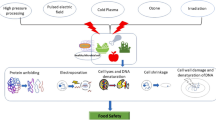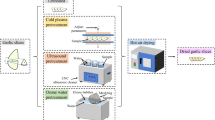Abstract
Millimeter waves are electric waves between 30 and 300 GHz. They are known to affect microbial growth. Here, the effects of millimeter waves on the microbiological and physicochemical properties of Makgeolli irradiated during fermentation were investigated. Millimeter waves at 60 and 70 GHz were used, and the fermentation was carried out at 30°C. The numbers of both lactic acid bacteria and yeasts have changed with similar pattern each then during the fermentation, but the effect of milimeter wave treatment was not critical as growth patterns were independent of both irradiation period and wave frequency. Furthermore, pH and total acidity did not change during fermentation. Although irradiation drastically increased sugar production during the initial stage of fermentation, the change was not frequency dependent. At the end of fermentation, the alcohol content in irradiated Makgeolli was definitely higher than that in un-irradiated Makgeolli, and the difference was frequency dependent.
Similar content being viewed by others
References
Park YP, Kim MD, Jung DH, Seo DH, Jung JH, Park JG, Hong SY, Cho JY, Park SY, Park JW, Shin WC, Park CS. Probiotic properties of lactic acid bacteria isolated from Korean rice wine makgeolli. Food Sci. Biotechnol. 24: 1761–1766 (2015)
Kwon YH, Lee AR, Kim HR, Kim JH, Ahn BH. Quality properties of makgeolli brewed with various rice and koji. Korean J. Food Sci. Technol. 45: 70–76 (2013)
Cho HK, Seo WT, Lee JY, Cho KM. Quality characteristics of cereal makgeolli rice nuruk prepared Rhizopus oryzae CCS01. J. Korean Soc. Food Sci. Nutr. 47: 1002–1008 (2012)
Jeong ST, Kwak HJ, Kim SM. Quality characteristics and biogenic amine production of makgeolli brewed with commercial nuruks. Korean J. Food Sci. Technol. 45: 727–734 (2013)
Beak SY, Kim JY, Yun HJ, Choi JH, Choi HS, Jeong ST, Yeo SH. Quality characteristics of makgeolli and nuruk grain inoculated with Aspergillus oryzae N041. J. East Asian Soc. Diet. Life 21: 877–881 (2011)
Lee H, Lee TS, Noh BS. Volatile flavor components in the mashes of takju prepared using different yeasts. Korean J. Food Sci. Technol. 39: 593–599 (2007)
Park CW, Jang SY, Park E J, Yeo SH, Jeong YJ. Quality characteristics of rice makgeolli prepared by mashing types. Korean J. Food Sci. Technol. 44: 207–215 (2012)
Kim E, Chang YH, Ko JY, Jeong Y. Physicochemical and microbial properties of Korean traditional rice wine, makgeolli, supplemented with mulberry during fermentation. J. Korean Soc. Food Sci. Nutr. 42: 1682–1689 (2013)
Kim E, Chang YH, Ko JY, Jeong Y. Quality characteristics of makgeolli added with kiwifruit (Actinidia deliciosa). J. Korean Soc. Food Sci. Nutr. 42: 1821–1828 (2013)
Lee TJ, Hwang DY, Lee CY, Son HJ. Changes in yeast cell number, total acid and organic acid during production and distribution processes of makgeolli, traditional alcohol of Korea. Kor. J. Microbiol. 45: 391–396 (2009)
Lee SJ, Kim JH, Jumg YW, Park S, Shin WC, Park CS, Hong S, Kim GW. Composition of organic acids and physiological functionality of commercial Makgeolli. Korean J. Food Sci. Technol. 43: 206–212 (2011)
Kim JY, Yi YH. pH, acidity, color, amino acids, reducing sugars, total sugars, and llcohol in puffed millet powder containing millet takju during fermentation. Korean J. Food Sci. Technol. 42: 727–732 (2010)
Jin J, Kim SY, Jin Q, Eom HJ, Han NS. Diversity analysis of lactic acid bacteria in takju, Korean rice wine. J. Microbiol. Biotechnol. 18: 1678–1682 (2008)
Seo DH, Jung JH, Kim HY, Kim YR, Ha SJ, Kim YC, Park CS. Identification of lactic acid bacteria involved in traditional Korean rice wine fermentation. Food Sci. Biotechnol. 16: 994–998 (2007)
Kim H, Lee K, Yong H, Jo C. Effect of UV-C and electron beam irradiation of on the quality of rice wine. Korean J. Food Preserv. 20: 45–51 (2013)
Grundler W, Keilmann F, Putterlik V, Strube D. Resonant-like dependence of yeast growth rate on microwave frequencies. Brit. J. Cancer Suppl. 5: 206–208 (1982)
Mattar J, Turk M, Nonus M, Lebovka N, Zakhem HE, Vorobiev E. Stimulation of Saccharomyces cerevisiae cultures by pulsed electric fields. Food Bioprocess Tech. 7: 3328–3335 (2014)
Furia L, Hill DW, Gandhi OP. Effect of millimeter-wave irradiation on growth of Saccharomyces cerevisiae. IEEE T. Bio-Med. Eng. 33: 993–999 (1986)
Usatii A, Molodoi E, Rotaru A, Moldoveanu T. The influence of low intensity millimeter waves on the multiplication and biosynthetic activity of Saccharomyces carlsbergensis CNMN-Y-15 yeast. Annals of Oradea University, Biology Fascicle 17: 208–212 (2010)
Dardanonl L, Torregrossa MV, Zanforlin L. Millimeter-wave effects on Candida albicanscells. J. Bioelectricity 4: 171–176 (1985)
Gos P, Eicher B, Kohli J, Heyer W-D. Extremely high frequency electromagnetic fields at low power density do not affect the division of exponential phase Saccharomyces cerevisiae cells. Bioelectromagnetics 18: 142–155 (1997)
Lee Y, Kim H, Eom T, Kim SH, Choi GP, Kim M, Yu S, Jeong Y. Quality characteristics of Korean traditional rice wine with glutinous rice. J. Korean Soc. Food Sci. Nutr. 42: 1829–1836 (2013)
Miller GL. Use of dinitrosalicylic acid reagent for determination of reducing sugar. Anal. Chem. 31: 426–428 (1959)
Yoon SS, Choi JA, Kim KH, Song TS, Park YS. Populations and potential association of Saccharomyces cerevisiae with lactic acid bacteria in naturally fermented Korean rice wine. Food Sci. Biotechnol. 21: 419–424 (2012)
Lee HL, Kang KW, Seo DH, Jung JH, Jumg DH, Kim GW, Park SY, Shin WC, Shim HS, Park C S. D iversity of lactic acid b acteria (LAB) in makgeolli and their production of γ-aminobutyric acid. Korean J. Food Sci. Technol. 47: 204–210 (2015)
Pakhomov AG, Akyel Y, Pakhomova ON, Stuck BE, Murphy MR. Current state and implications of research on biological effects of millimeter waves: A review of the literature. Bioelectromagnetics 19: 393–413 (1998)
Sonng JC, Park HJ. Takju brewing using the uncooked germed brown rice at second stage mash. J. Korean Soc. Food Sci. Nutr. 32: 847–854 (2003)
Son HS, Park BD, Ko BK, Lee CH. Quality characteristics of takju produced by adding different amounts of water. Korean J. Food Sci.Technol. 43: 453–457 (2011)
Byeon J, Choi E, Kim W. Effect of low frequency (20-35 kHz) airborne ultrasonication on microbiological and physicochemical properties of soybean Koji. Food Sci. Biotechnol. 24: 1035–1040 (2015)
Chen YP, Liu YJ, Wang XL, Ren ZY, Yue M. Effect of microwave and He-Ne laser on enzyme activity and biophoton emission of Isatis indigotica Fort. J. Integr. Plant Biol. 47: 849–855 (2005)
Jeon MJ, Jang MK, Lee SJ, Park SH, Kim M, Sohn JH, Lee HS, Lee DG, Lee SH. Variations of properties and microbial community during fermentation of makgeollies by isolated yeasts from traditional makgeollies. J. Life Sci. 23: 796–803 (2013)
Author information
Authors and Affiliations
Corresponding author
Rights and permissions
About this article
Cite this article
Seo, DH., Kim, MS., Park, CS. et al. Effect of millimeter waves on the microbiological and physicochemical properties of Korean rice wine Makgeolli . Food Sci Biotechnol 25, 497–502 (2016). https://doi.org/10.1007/s10068-016-0069-8
Received:
Revised:
Accepted:
Published:
Issue Date:
DOI: https://doi.org/10.1007/s10068-016-0069-8




